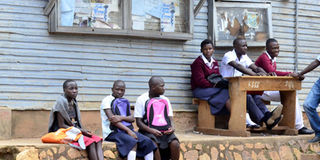Violence against learners still high

Students sit outside their classrooms on the first day at school last year. A survey indicates that some secondary school students suffer violence but remain silent. PHOTO BY Rachel Mabala
What you need to know:
On the backdrop of fundamental human rights, every child in Uganda has a right to access education. This education ought to be delivered in a conducive and safe learning environment that is free of violence, but a survey by Education Local Expertise Centre Uganda reveals this is not always the case.
Grace, 16, a resident of Kikajjo, Namasuba is a single teenage mother nursing her five months old baby girl. She actually looks younger than her age and it is evident as you strike into conversation that she is very sad, and bitter.
“I was just going to join Primary Seven when this – (pointing to the baby) happened,” she begins to narrate the story of how she ended pregnant with her former teacher’s baby. “At the start, he was just friendly and I thought he was being nice but every time there were no pupils around, the teacher would touch me inappropriately,” she narrates. This caused her to start avoiding him.
One day as he coached her, he told her she was very beautiful and that he wanted to know her further. “I refused. He got very angry and forced himself on me,” she sadly reminisces.
Rampant
Other than sexual violence, violence in school takes many forms. In 2016, the Education Local Expertise Centre Uganda (ELECU), was retained by the Global Health Uganda to implement a one-year project to lead efforts of promoting processes of fostering prevention of violence against children in schools.
The project, which is being implemented through dialogue, learnings, sharing of evidence, leadership development, consensus building and local innovation, recently released a policy paper based on study findings.
It highlighted the current status of violence against children, good practices for prevention and how available government policies can further be strengthened to offer results.
Sexual violence
The study found out that children are teased or and get sexual comments about their breasts, genitals, buttocks or other body parts or their bodies touched in sexual ways. There are also cases when adults or peers endeavour to kiss children or make them touch their genitals, breasts or buttocks when they do not want to. Others are enticed with gifts and money in exchange for sex or threatened and pressured. Sexual abuse at school came highest at 77.7 per cent in primary school and 82 per cent in secondary school.
Perpetrators include male teachers at 67 per cent, 22 per cent by fellow students, 5 per cent by female teachers and 6 per cent by non-teaching staff. Majority of survivors (60.2 per cent) never reported cases.
Emotional violence
Emotionally parents, peers, schoolteachers and other staff, and relatives abuse children. Sometimes pupils are denied entry into classrooms, made to stand in rain or extreme sunshine, their food taken away while others are eating, low marks read to the whole class, cursed, insulted, shouted at and humiliated among peers.
This constituted 46.7 per cent of children surveyed perpetrated by teachers whereas bullying constituted 43 per cent; 46 per cent in primary schools, and 31 per cent in secondary schools.
Physical violence
According to the report, this includes choking, severe beatings, among others. Moderate physical punishment includes hurting, slapping the face or head as punishment, twisting ears, arms, hitting by throwing objects, hitting with a closed fist, especially by male teachers, hitting with a stick, caning, kicking, knocking the head, pulling of hair, make a child slash a field or do other labour as punishment, making them stand or kneel in a way that hurts, tying a child with a rope or belt for wrongdoing.
It is further indicated that even with the ban on corporal punishment by the ministry of Education, caning remains a common practice perpetrated by parents, peers, teachers and other school staff, relatives and other adults along the way from school to home.
Statistics
Physical abuse at school: Corporal punishment such as caning - 75 per cent (of learners surveyed in government schools and 73 per cent in private schools experienced caning, 74 per cent in primary and 75 per cent in secondary).
Kicking: 45 per cent of children in primary schools were kicked and 31 per cent in secondary schools.
Hitting: 45 per cent in primary and 27.3 per cent in secondary schools. eastern Uganda was leading with 60 per cent, followed by the western with 45 per cent. More boys (49 per cent) than girls (41 per cent) were hit.
Beating: 70.9 per cent in primary and 57.7 per cent in secondary schools were beaten. Eastern Uganda was leading with 82 per cent, followed by central with 68 per cent.
Policy approaches
In 2012, the government of Uganda through the ministry of Education, Gender ministry with support from UNICEF established the Inter-Sectoral Committee on Violence Against Children in Schools [ISC VACiS] which has been responsible for the development of the National Strategy on Violence Against Children in Schools and a National Action Plan on Violence against children in schools.
This (National Action Plan on Violence against children in schools) sets out policies, some of which the ELECU policy paper analyses and discusses.
Recommendations: There is a wealth of practice, knowledge, experience and evidence indicating prevention interventions are both viable and acceptable but further notes that, “This option will require the MoES and Ministry of Finance to agree on the resources necessary for undertaking this assignment over a medium-term period,” it reads.



